|
::
[ 1898 Créanche Tricycle made by Ph. Marot, Gardon et
Cie ] ::
We are always glad to receive corrections or
updates on any of our identification as we pride ourselves on trying to achieve
correctness in all our investigations. On our HELP PAGE 106 we
were investigating two photographs by the famous French photographer
Jules Beau (1864-1932). These were of a Tricycle and a Quadricycle. The
problem with identifying these vehicles is that while we were aware of
differing frame and axle arrangements on differing makes, many used the proprietary
De Dion Bouton engine which was supplied with the large triangular tank
below the saddle, and on both sides of this tank were very large De Dion
Bouton badges. They also put De Dion Bouton Badges on the tank under the
crossbar. Some put their own name on the on the tank under the crossbar.
To make matters more difficult, De Dion Bouton's own Trikes had the same
badging system of De Dion Bouton badges on both tanks.
After study of the photos by our various experts we reported our view
that these vehicles were De Dion Bouton. However we have subsequently
had some very interesting and detailed email correspondence with a
couple of 1899 Trike specialists who have brought our findings into
question. In view of the very fascinating in-depth details determined,
we are publishing the correspondence which may be of interest to other
Trike enthusiasts :
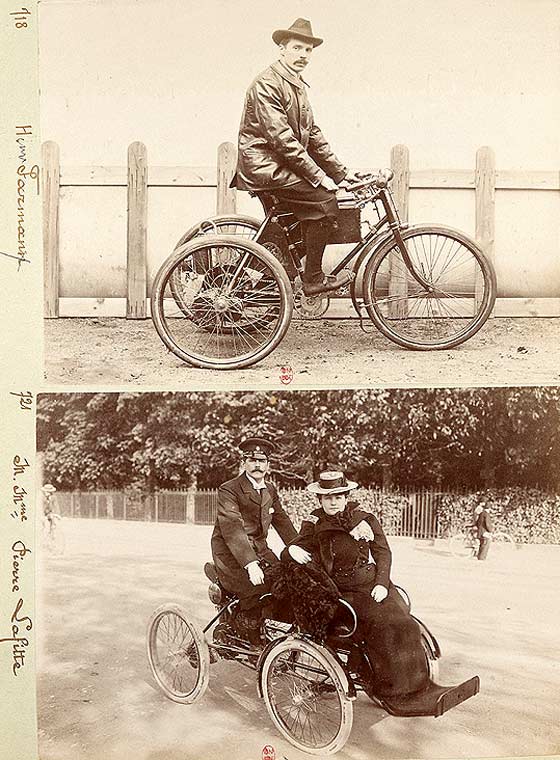
---------------------------------------------------------------------------------------------------------
From our Help Page 106
DENTIFICATION AND DATING:1900 De Dion Bouton Tricycle Surfing through
the internet in attempting to identify old vehicles we came across a
Wikipedia Website Page called Unidentified Automobiles where they are
asking identification. -- This
is a photo from an album by famous French photographer Jules Beau
(1864-1932) specialising in 'sport'. This is a French vehicle made in
Paris, forerunner of the then world's biggest manufacturer. This is a
cca 1900 De Dion Bouton Tricycle introduced 1895 as 132cc 1.25 HP, then
1.75, 2.75, by 1904 955cc 8HP. 1900 De Dion Bouton Tricycle
IDENTIFICATION AND DATING:1900 De Dion Bouton Quadri
Cycle Surfing through the internet in attempting to identify old
vehicles we came across a Wikipedia Website Page called Unidentified
Automobiles where they are asking identification. --
This is a photo from an album by famous
French photographer Jules Beau (1864-1932) specialising in 'sport'. This
is a French vehicle made in Paris, forerunner of the then world's
biggest manufacturer. This is the follow-on from the successful Tricycle
being a cca 1900 De Dion Bouton Quadri Cycle, also a 'Forecar'.
---------------------------------------------------------------------------------------------------------
In February 2018 we received the following
email from Leon Mitchell of Adelaide, Australia:
I enjoy browsing your "Help Pages". Can
I comment on a couple of older identifications on page 106? Best regards, and keep up the good work.
The entry which is shown as "De Dion Bouton Tricycle" has a
De Dion engine (c1898, after the side-by-side valves and before the
"cloche") and ancillaries but it not a De Dion tricycle.
Instead it is a Créanche (Ph. Marot, Gardon & Cie, Paris). The
major identification points are the rear axle mounting - DDB always used
a "bridge" to take the weight, but here the back axle takes
the weight - and the front fork has a two-plate head, unlike the
triangulated DDB fork of the era. The chain wheel is also very Créanche.
I'd go for "c1898 Créanche Tricycle".
The entry which is shown as "De Dion Bouton Quadricycle" may
also have a DDB engine, but again the chassis has no bridge to support
the rear hubs, so it's not a DDB quad. The photo on the site is a little
small, but I think I can make out two rear "chain stays"
joining the back axle on either side of the differential. This rules out
Rochet, and puts us back into Créanche territory. I wonder were the two
photos taken by Beau in the same session - maybe some Créanche
advertising? I'd go for "Most likely c1900 Créanche Quadricycle".
(Just to complicate things, Marot, Gardon &
Cie advertised their machines as "Créanche-Comiot" for a
while - not sure where this fits in, but the Eadie double front fork
fitted by Comiot is usually an identifying feature - not very useful on
the quad!)
---------------------------------------------------------------------------------------------------------
As we normally double check all information
received, we contacted our 'obscure veteran vehicles specialist' Ariejan
Bos for a second opinion, and he advised :
I'm letting another specialist look at the photos. He recently bought a
Marot-Gardon quadricycle!
The background to Ph. Marot, Gardon et Cie of Corie Somme, France,
is that they were founded in 1898 with offices in Paris and works in
Corbie, near Amiens. They started by manufacturing bicycles possibly as
early as 1896 and later Tricycles and Quadricycles. These were powered by De Dion Bouton Engines.
They also made specific racing tricycles. It seems they may
also have manufactured motorcycles in 1899. Additionally, in 1899 they introduced a
3HP single cylinder Voiturette and then a 4.5HP Voiturette. Following
year a couple of additional automobile models were introduced, a two-seater with a front
mounted 6hp horizontal engine, and a racing Voiturette with a 7HP
Soncin engine. Their Agents in the UK were William H M Burgess of
Farringdon Road, London. Notwithstanding, Ph. Marot, Gardon et Cie seem to have ceased
production in 1902.
---------------------------------------------------------------------------------------------------------
We subsequently heard from specialist, Nick
Jonckheere, and he confirmed as follows:
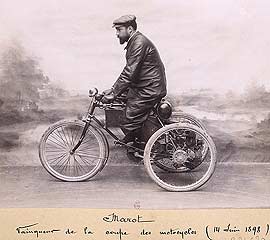
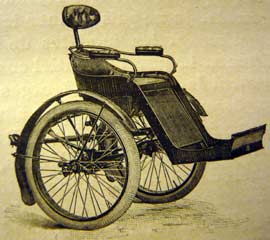
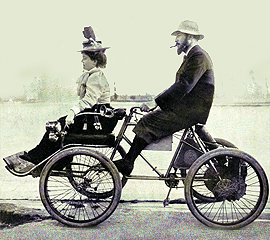
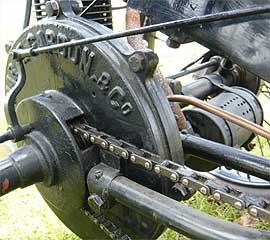
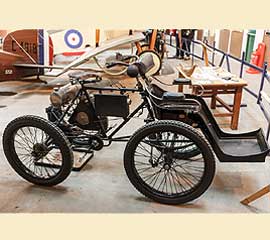
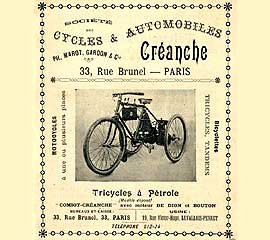
Photo Beau 'Marot' is of course Mr. Marot himself,
on his 1898 M-G, note the oval tank (absent on some trikes, those only
rode short trips on the fuel present in the triangular surface carb), I
think rather typical for M-G. The removable attachment of the pedal gear
to the frame, was, I thought, rather typical for M-G quads, but here we
see it on a trike too. Some trikes also had it firmly built-in the
frame. The 'caged' chain is also rather typical for M-G, I think, but of
course, could be removed for weight reduction (eg if racing).
The 'Henri Farman' picture has a lot of resemblance to a M-G..., but I'm
still not 100% convinced it is a M-G... Front fork and rear axle are OK,
but I'm not sure about the differential box form, and its reinforcing
plates towards the shaft tubes (I have not seen these on any known M-G
picture, period or of surviving machines, but that is only until a new
picture which has them turns up !). Also a typical M-G feature is the
'splicing' of the frame from just behind the pedal gear towards the back
axle (see picture 874, the Shuttleworth M-G quad, which is exactly the
same as mine). I think the 'Farman' picture has this too (especially if
you consider what I'm writing about the Lafitte quad), but with rather
sturdy tubes, compared to mine and the ones on the M-G that was
auctioned last weekend by Artcurial...
The two-plate front-fork was used by other trikes too, I don't consider
it typical for M-G/Créanche. The springs are always similar,
quarter of an ellips for the top, half-ellips at the bottom.
CONCLUSION: I think the careful
identification by Leon cannot be bettered at the moment ! The trike
possibly a Créanche (or M-G), and the quad the same marque, but in my
opinion not with a M-G forecarriage (which might be a bit unlogical).
---------------------------------------------------------------------------------------------------------
However a few days later Nick
Jonckheere sent a follow-up email:
Although I'm fairly new to in-depth trike
and quad study, I'm on a steep learning curve, and after many dozens of
clicks, I'm now convinced that both the trike and quad we were looking
at (Henry Farman and Mr and Mrs Lafitte's) are Phébusses (Phébae?) !
I'm convinced, mainly because of the 'spliced' frame, behind the pedals,
the 'heavier-than-Marot Gardon' tubes of that part, and the triangular
reinforcement plates that go from the differential box towards the axle
tubes. I came to this conclusion by flicking through more Jules Beau
pictures on Gallica, many trikes are unidentified, but one quad has 'Phébus'
painted on the forecarriage, and other pictures on the internet
confirmed this.
But then one can start looking at front forks, and get puzzled again ...
---------------------------------------------------------------------------------------------------------
To which Leon
Mitchell of Adelaide replied:
I am eating my breakfast here in Australia,
laughing at our enthusiasm for turn-of-the-20th-century motor tricycles.
It's particularly ridiculous out here, where there was never more than a
handful of the things! Fun, isn't it? We are lucky to be able to indulge
in such wicked pleasures.
Yes Phebus is a possibility, but if you look at Deschamps and others
you'll confuse yourself further. I suspect the real question is
"Where did the axle parts come from?" You make a good point
about the strengthening webs on the differential housing.
The origin of "Creanche" is that Louis Creanche patented a
rear axle in the first week of 1898, where the axle was enclosed in a
housing strong enough to be used without the Humber/DDB "bridge/pont".
The Creanche axle used (at least in the patent drawings) a differential
using bevel gears. Thus (I think) a Comiot tricycle with a bridge frame
is a Comiot, but a Comiot using a Creanche back axle is a
Comiot-Creanche. Usually (?!) the right-side chainstay attaches to the
housing that encloses the pedal sprocket at the rear, but the left-side
stay attaches to the thin part of the axle tube, out board of the diff
housing.
Automoto marketed a similar axle, but using straight-cut gears in the
diff. The band brake was inside the housing on the right, and the chain
stays BOTH attach to the housing. I suspect a number of makers sourced
Automoto kits to built their machines, while some sourced Creance (built
by Marot Gardon?), and maybe others used parts from Decauville who built
the cycle parts for DDB tricycles in 1897 and 1898, or even from Clement
who built the DDB trikes after the fire at Decauville. Then there was
Rochet, the British manufactures, and all the others! It may well be
that all Automoto axles have strengthening webs on the outside and
straight cut gears inside, but let me think about this some more.
Re forks: The special ones are easy. DDB has its thin-tube girder. The
Automoto-style has the double blades (fore and aft) from the lower fork
crown to the axle, and a single (oval) tube to the top crown. The
Comiot-Eadie style has double blades, but one inboard of the other (this
was an Eadie (UK) patent, and there was a link between Comiot and Eadie
in the late 1890s). Then there are numerous varieties of "heavy
push bike" style fork.
My strong suggestion is to ignore (or at least not to rely on) anything
modern with paint on it when looking for evidence! There are many trikes
around now that are quite different from when they left the factory 120
years ago, plus many good ones that have been wrongly identified - maybe
60+ years ago - and have lived with their (false) identities for a long
time. Oh, and don't believe everything you read in period literature.
Attached is a Scientific American article from May 1899 describing the
"De Dion Bouton Tricycle" - fine, except that the machine
described is (I think) Automoto, albeit powered by a De Dion Bouton
motor! It's a really difficult area.
Return to
Help Page
|